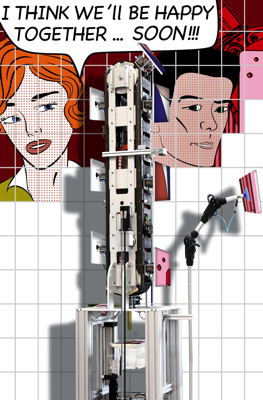Polymer technologies create €27,000 `assembly line`
![]() At the recent Hannover Fair, the plastics engineering specialist igus was showing how polymer components can be used to achieve low-cost automation in a demonstration that brought together several of its recent modular technologies to assemble a pop-art painting, rather like a jigaw puzzle.
At the recent Hannover Fair, the plastics engineering specialist igus was showing how polymer components can be used to achieve low-cost automation in a demonstration that brought together several of its recent modular technologies to assemble a pop-art painting, rather like a jigaw puzzle.

These technologies used in the demonstration (above) included:
• the pikchain continually-revolving pick-and-place chain that can carry loads of up to 5kg load per link;
• the polymer-based robolink multi-axis robot system which can handle loads of up to 1kg per joint; and
• the drylin E lubricant-free linear drives, which can handle loads of up to 50kg.
In the Hannover demo, these technologies were jointly performing typical automation tasks such as sorting, identifying, gripping and moving.
First, non-sorted tiles that together would create the final image were delivered by a drylin E linear drive from a magazine to the pikchain system. The pikchain picked up the tiles using a suction gripper. A vision system identified the tiles, which were then picked up by a robolink jointed arm in a set sequence and positioned to create the finished picture. As soon as the picture had been completed, the process was reversed.
Frank Blase, igus’ managing director, acknowledges that an application of this sort is unlikely to be found in a factory but, he adds, “the line still illustrates the capacity of the components”.
The line could be extended by further actuators, tools or sensors to process or test components during movement of the pikchain. “The line demonstrates that our low-cost components can be easily combined into harmonious automation solutions,” says Blase.
igus estimates the total cost of building the line, including programming, was €27,000 (about £21,850) with its own components representing about a third of the cost.

At Hannover, igus also presented a new version of the pikchain (above). The principle of remains the same: a continuously rotating chain with integrated energy and data supplies, and individually controllable links. The new PC2 version is based on a low-priced, modular energy chain kit with a 2kg load capacity per link (compared to the original 5kg). The side parts have low-friction guiding elements made of a tough polymer plain bearing material. Various widths and interior separations are available. Connection plates with integrated thread nuts can be fitted with grippers, cameras, tools or processing equipment. A rotating chain that supplies the links with signals, energy and media, can be adjusted steplessly like a drive belt.





